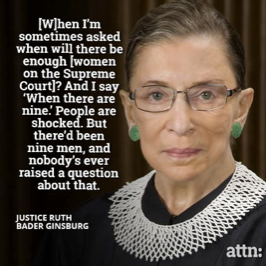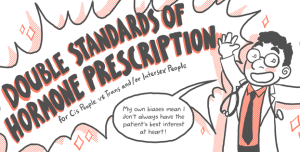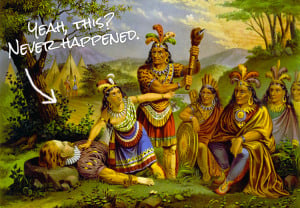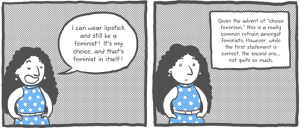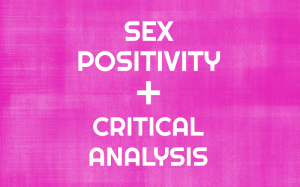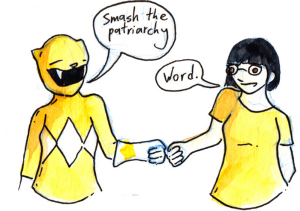Like the millions in the U.S and Canada who dropped $238 million to shatter the domestic box office record for opening weekend, I quickly lined up to see “Star Wars: The Force Awakens,” the continuation of a franchise that began when I was just three years old — about the age of my oldest child.
I want my children to enjoy these films as much as I once did.
Unfortunately and fortunately, I’m a bit more socially conscious than I was back in 1977.
In an earlier Everyday Feminism article, “6 Sexist, Racist, and Generally Messed Up Things We Hope The New Star Wars Films Get Right This Time,” I outline six sexist, racist, and generally messed up things we hope the new Star Wars films get right this time.
Here are my six criticisms of the first six movies, using a lens of social justice:
- They Heavily Exclude Women and People of Color
- They Don’t Let the Women Do
JackJane - They Heavily Objectify Women
- They Exclude More Than Just Women and People of Color
- They Racialize the Antagonists and (Attempted) Comic Relief
- They Show the Jedi to Be Weapons for the Rich and Powerful
Not everyone agreed with these critiques, especially, I imagine, the “handful” of not-so-subtly racist trolls who started the #BoycottStarWarsVII hashtag in response to trailers that featured “not one, but multiple people of color.” (Of course, it wasn’t just trolls who resisted my calls for improved representation in Star Wars.)
But this film improves on many of the failings of previous installments. Here are 6 ways it does so.
(Also, I’ll do my best to focus on these points and not spend time on non-social-justice-specific discussions, like how well director J.J. Abrams successfully restores the humor, spirit, and pacing of the original trilogy and how much he unfortunately recycles former plots; four of the seven movies culminate in blowing up something big to save the day.)
1. It Doesn’t Exclude Women and People of Color
Much improved on both fronts! Don’t get me wrong: it’s still a mostly male movie, as background extras tend to be men and every white stormtrooper armor seems to be filled with a man.
It was going to be every stormtrooper, but, late in the game, after a male-heavy cast was announced, director J.J. Abrams cast Gwendoline Christie as Captain Phasma.
At the same time, in “The Force Awakens,” we can finally watch women womanning war room control panels, piloting T-70 X-wing fighters, and mentoring young White out-of-balance galaxy saviors.
And, best of all, the film’s protagonist is Rey, played by Daisy Ridley, who provides children many positive qualities to emulate. More on her next.
Racial representation is also improved. The days of just one significant hero of Color — Lando Calrissian in the original trilogy and Mace Windu in the prequels — appear to be over. Now we have two (three if you count Maz Kanata, Lupita Nyong’o’s C.G.I. character)!
I’ll let you decide if that last sentence is genuine excitement or biting sarcasm (and, truthfully, I’m conflicted.)
But let’s not forget that John Boyega is no heroic sidekick. Boyega is one of the primary heroes, even if his image was significantly reduced in Chinese promotional posters.
2. It Actually Lets the Women Do Jack Jane
“The Force Awakens” obliterates this criticism. Again, don’t get me wrong: this issue is obliterated primarily by the actions of one character, Rey. Yes, the two-hour adventure includes other significant female characters—General Leia Organa and Maz Kanata (more on her later)—but their roles are relatively minor.
In contrast, significant male characters—Finn, Han Solo, Chewbacca, and Poe Dameron—enjoy far more of the doing—and the screen time—throughout the film.
(And how hard would it have been to establish Captain Phasma’s dominance on the battlefield? If you watched Gwendoline Christie’s Game of Thrones character, Brienne of Tarth, take down the Hound in one of the most brutal fight sequences I’ve ever seen, you know Christie could steal the show in any battle. )
But it’s easy not to notice any of these shortcomings because of Rey (ignoring for a moment that J.J. Abrams cast someone who could likely make the covers of magazines even without her formidable acting abilities).
With her advanced-level scavenging, self-sufficient living, Han-Solo-like piloting, quick-study shooting, (spoiler) dueling, and faster-than-Luke learning of the (spoiler), Rey embodies so much badassery (though, arguably, on traditional male terms) that children, regardless of gender, will want to become her.
I’m now sure Zinn, my four-year-old, would want to, though I wouldn’t have known that a year ago. Bear with me for a short anecdote:
As a resident of a very White neighborhood and city, I tried to normalize racial diversity for Zinn by showing him short concert videos of my folk-music favorites like Tracy Chapman and Thao. Then Zinn stumbled upon a more rocking Death Cab for Cutie song that he liked so much that, for months and months, the soundtrack of our household became Death Cab—only Death Cab. In front of a mirror, with his ukele strapped over his shoulder, he relentlessly mimicked frontperson Ben Gibbard.
(If you are one who doubts the profound impact of media on our children, know that these influential videos of concert footage amounted to just 10-15 minutes a day. The Force most powerful to our children in our galaxy may be screens).
Deep into Death Cab, Zinn rejected any new music played by women. He explicitly said no women. That is until Jess, my wife, showed him a group that could rock harder than Death Cab: Sleater-Kinney. And Carrie Brownstein instantly replaced Ben Gibbard as the guitarist Zinn emulated.
Ridley’s Rey is the Sleater-Kinney of Star Wars. In an interview, Ridley discussed the importance of her character: “She will have some impact in a girl power-y way. She’s brave and she’s vulnerable and she’s so nuanced… She doesn’t have to be one thing to embody a woman in a film. It just so happens she’s a woman but she transcends gender. She’s going to speak to men and women.”
3. It Doesn’t Objectify Women
Not anymore! While the Dark Side has yet to be eradicated from the galaxy, objectification sure has.
And I wasn’t sure if that was going to be the case after J.J. Abrams slipped a moment of gratuitous objectification into “Star Trek Into Darkness,” a moment that also made it into the trailer (and a moment that at least resulted in an apology from one of the film’s writers).
“The Force Awakens” stays clear of such objectification, even in background shots and an updated Mos Eisley Cantina-like scene. As I cite in my previous article, the rampant objectification of women is a serious form of sexism. According to Ms. Magazine objectification “has been linked to problems with mental health, eating disorders, body shame, self-worth and life satisfaction, cognitive functioning, motor functioning, sexual dysfunction, access to leadership, and political-efficacy.”
Rey, the most likely candidate for objectification, remains free of this default treatment. Megan Garber, in the Atlantic’s “Star Wars: The Feminism Awakens” describes Rey’s primary garb: “pants and a tunic made of sun-bleached fabric, bands that extend the length of her arms, thick-soled boots, a leather belt looped several times around her waist.”
In other words, exactly what you’d expect a resident of Tatooine to wear. I mean Jakku.
Even if the galaxy seems to have gone to shit since the galaxy-wide victory celebrations of Episode VI’s denouement, J.J. Abrams has given us feminists something to celebrate.
4. It Continues to Exclude More Than Just Women and People of Color
In this criticism, I called for a galaxy that is more inclusive of the vast diversity of gender and sexual identities. After two viewings, I’m still undecided if the connection between Finn and Rey is romantic. I suppose I can’t be wrong to say that it’s potentially romantic. Sexual identity seems to be, for the most part, off the table in this film. And that’s fine.
But let’s remember the recent release of “Jessica Jones” and how easily the makers of the show integrated a gay couple without their sexual identity becoming a plot point. Normalizing queer relationships — even in 2015 — can still feel like a radical act.
Let’s also remember that our media overwhelmingly represent not just heterosexual people but also cisgender people (not to mention many other demographics we could discuss). Gender diversity comes in many forms and our media need to reflect that fact.
There’s no reason that Star Wars should be exempt from this expectation.
5. It Doesn’t Racialize the Antagonists and (Attempted) Comic Relief
Much improvement here! Probably having more to do with returning to the glory of the original trilogy and less to do with racial justice, J.J. Abrams mostly avoids the accented (at least not American-accented) C.G.I. inhabitants of the galaxy that George Lucas embraced in the prequels — the ones that even Time Magazine labeled “uncomfortable ethnic stereotypes.”
But we need to analyze Lupita Nyongo’s character, Maz Kanata. Her inclusion did help the film pass the Bechdel Test (in which two named female characters talk about something other than men — though Freud might disagree that the film passed since they discuss a lightsaber).
At the same time, casting folks of Color and then hiding their color is a problem. I elaborate more here, but masking Lupita Nyong’o’s dark skin in C.G.I is hardly an isolated decision.
Rather, it’s part of a long pattern of film and TV hiding, minimizing, or altering the characteristics of actors of Color, especially Black actors. Zoe Saldana’s skin becomes blue in “Avatar” and green in “Guardians of the Galaxy.” Jamie Foxx’s skin becomes blue in “Amazing Spider Man II.” Two Black characters from “Agents of S.H.I.E.L.D.” morph into beings no longer clearly Black.
And the pattern will extend into 2016 with “Captain America: Civil War.” The costume of Black Panther hides T’Challa’s blackness.
At the same time, the film did pass the Race Bechdel Test (in which two named characters of Color discuss something other than White people). But just barely.
The test-passing conversation between Finn and Poe Dameron, played by Guatemalan American Oscar Isaac, almost didn’t happen.
Originally, Isaac’s character was written to be “promptly killed off.” Had Dameron been killed, many of us would have been unsurprised.
Despite Latinxs making up 17.4 of the U.S. population, their representation in Hollywood continues to be notoriously low, as the following Mic.com graph demonstrates:
With such egregious underrepresentation, not to mention gross misrepresentation, of Latinxs, elevating Dameron from a casualty to a hero matters.
6. It Remains To Be Determined If the Jedi Are Improved Badasses
How J.J. Abrams does regarding this criticism is still to be decided. In my original article, I critique that the spiritual leaders of the galaxy too quickly turn to violence, regularly lopping off limbs and even heads, all at the behest of the Republic’s rich elite.
As a parent, I’m hyperconscious of the reality that so many of the sagas we love — Star Wars, Harry Potter, Hunger Games — “are still war movies”— even the most progressive epics like “Avatar: The Last Airbender” (the show, never the movie) and “The Legend of Korra.”
At least in the prequels, the Jedi mostly hack apart mindless droids. In this film, however, at the very moment Finn removes his helmet, the stormtroopers become increasingly humanized.
Will the inevitable return of the Jedi (again) include concern for the humanity of their enemies? Based on the climax of the “The Force Awakens,” it seems unlikely.
***
“The Force Awakens,” with its imaginative mythology and Disney’s marketing machinery, will invariably upload Star Wars into a new generation of children.
This time, however, Star Wars has offered children a choice they have virtually never had before: If you want to be a Star Wars hero, do you want to play the White woman, the Black guy, or the Latinx guy?
In the past, the most heroic options were always White guys. And if not this White guy then that other White guy (If not Luke, then Han; if not Anakin, then Obi-wan). The only White-guy-hero option in “The Force Awakens” is now 73-years-old (though, to be clear, still a hell of an option).
Thus, millions of White children will likely role-play a character who is not a young White male.
That’s a big fucking deal!
How many fewer misogynistic and racist White male trolls would we have to endure today had they spent their childhoods pretending to be White women or Black men or Latinx men?
In the end, I’m heartened by this new direction of Star Wars, a dominant fixture in American culture for nearly 40 years. If more movies follow suit, actors of Color will eventually no longer need to defend being cast as a protagonist, as Boyega recently did with irrefutable logic:
“I’m grounded in who I am, and I am a confident black man. A confident, Nigerian, black, chocolate man…I just don’t get it. You guys got every single alien in this movie imaginable to man. With tentacles, five eyes. Aliens that, if they existed, we’d definitely have an issue. We’d have to get them to the government and be, like, ‘What are you?’ Yet what you want to do is fixate on another human being’s color. You need to go back to school and unlearn what you have learned.”
Of course, I’m a bit more radical than your average movie critic. I’m still waiting for the day actors of Color outnumber White actors and nobody notices. After all, few notice or make a stink every time it’s the other way around, which is literally every time.
And that’s not Jon Greenbergian logic. It’s Ruth Bader Ginsburgian logic.
[do_widget id=’text-101′]
Jon Greenberg is a Contributing Writer for Everyday Feminism. He is an award-winning public high school teacher in Seattle who has gained broader recognition for standing up for racial dialogue in the classroom — with widespread support from community — while a school district attempted to stifle it. To learn more about Jon Greenberg and the Race Curriculum Controversy, visit his website citizenshipandsocialjustice.com. You can also follow him on Facebook, Tumblr, and Twitter @citizenshipsj.
Search our 3000+ articles!
Read our articles about:
Our online racial justice training
Used by hundreds of universities, non-profits, and businesses.
Click to learn more
Most Read Articles
- « Previous
- 1
- …
- 30
- 31
- 32






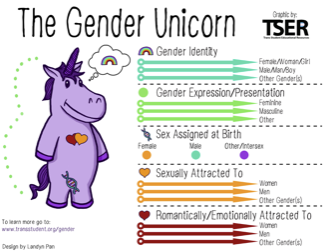 Source: TSER
Source: TSER


